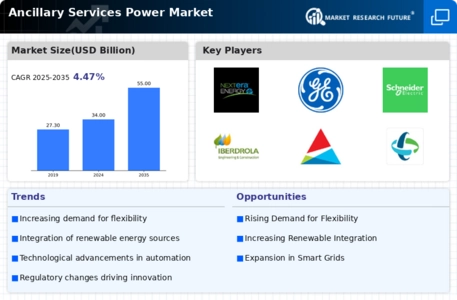Growing Demand for Grid Stability
The increasing complexity of power systems, driven by the integration of renewable energy sources, has led to a heightened demand for grid stability. Ancillary Services Power Market plays a crucial role in maintaining this stability by providing essential services such as frequency regulation and voltage control. As more intermittent renewable sources like wind and solar are added to the energy mix, the need for ancillary services becomes more pronounced. According to recent data, the ancillary services market is projected to grow at a compound annual growth rate of approximately 8% over the next five years. This growth is indicative of the industry's response to the challenges posed by fluctuating energy supply and demand, thereby ensuring a reliable and resilient power grid.
Technological Innovations in Grid Management
Technological advancements in grid management are significantly influencing the Ancillary Services Power Market. Innovations such as smart grid technologies and advanced analytics are enhancing the ability to monitor and manage power systems in real-time. These technologies facilitate better integration of renewable energy sources and improve the efficiency of ancillary services. For example, the deployment of artificial intelligence in grid operations can optimize the dispatch of ancillary services, leading to cost savings and improved reliability. The market for smart grid technologies is anticipated to grow substantially, with estimates suggesting a market size of over 100 billion dollars by 2026. This growth underscores the critical role of technology in shaping the future of ancillary services.
Regulatory Support for Clean Energy Initiatives
Regulatory frameworks are evolving to support clean energy initiatives, which in turn bolster the Ancillary Services Power Market. Governments are increasingly implementing policies that promote the use of renewable energy and the associated ancillary services required to support these technologies. For instance, mandates for renewable portfolio standards and incentives for energy efficiency are driving demand for ancillary services. As a result, the ancillary services market is expected to expand, with projections indicating a potential increase in market size by 15% over the next decade. This regulatory support not only encourages investment in ancillary services but also aligns with broader sustainability goals, fostering a cleaner energy future.
Rising Consumer Participation in Energy Markets
The shift towards decentralized energy systems is fostering greater consumer participation in the Ancillary Services Power Market. As consumers become more engaged in energy production and consumption, they are increasingly capable of providing ancillary services, such as demand response. This trend is supported by advancements in technology that enable consumers to manage their energy use more effectively. Recent data indicates that demand response programs could contribute to a reduction in peak demand by up to 10%, thereby enhancing grid stability. The growing involvement of consumers not only diversifies the sources of ancillary services but also empowers individuals to play a proactive role in the energy landscape, potentially reshaping market dynamics.
Increased Investment in Energy Storage Solutions
The rise of energy storage technologies is transforming the Ancillary Services Power Market. Energy storage systems, such as batteries, are increasingly being deployed to provide ancillary services, including load shifting and frequency regulation. These systems can store excess energy generated during low demand periods and release it during peak demand, thus enhancing grid reliability. Recent estimates suggest that the energy storage market could reach a valuation of over 200 billion dollars by 2030, with ancillary services being a significant contributor to this growth. The ability of storage solutions to respond quickly to grid needs positions them as vital assets in the ancillary services landscape, potentially reshaping how power systems operate.


















Leave a Comment